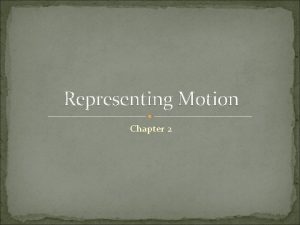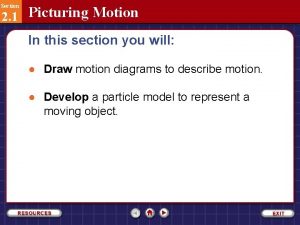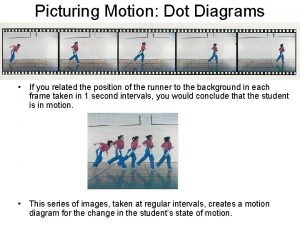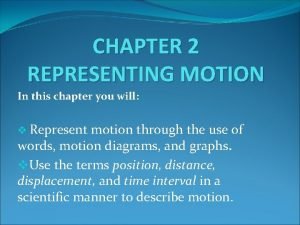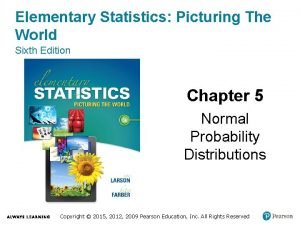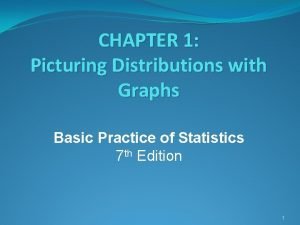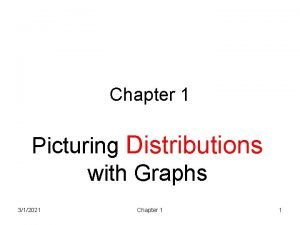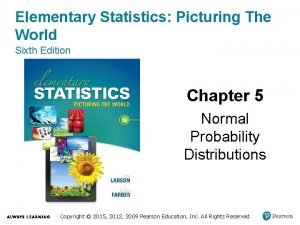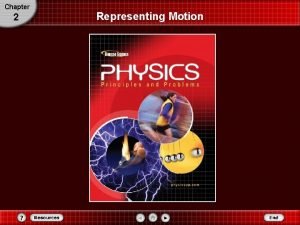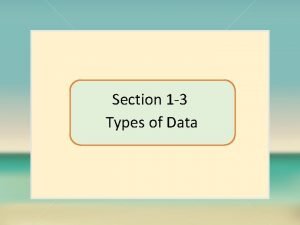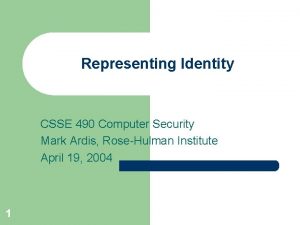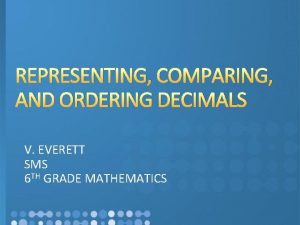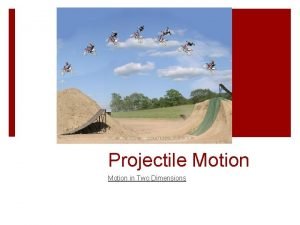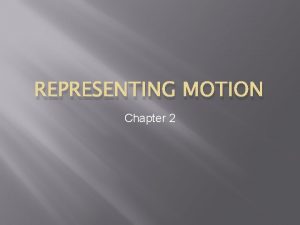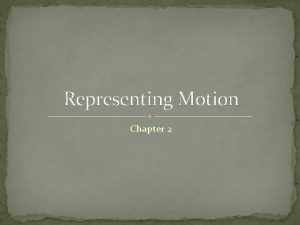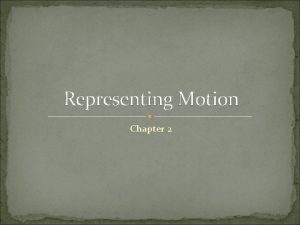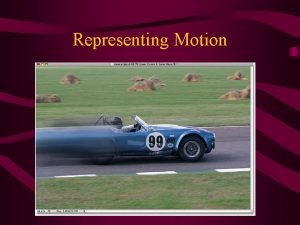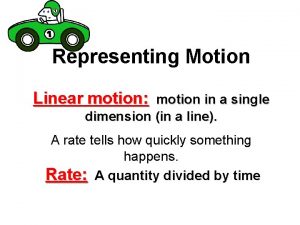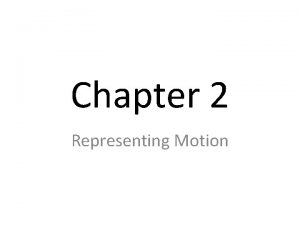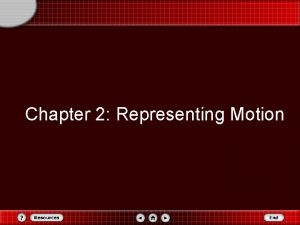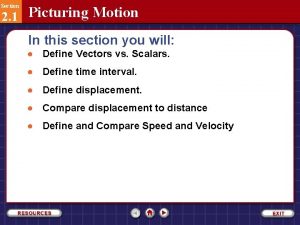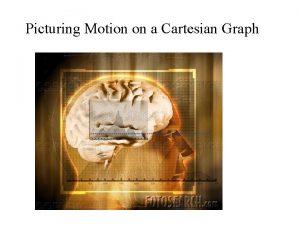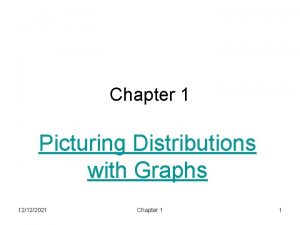Representing Motion Chapter 2 2 1 Picturing Motion



















- Slides: 19

Representing Motion Chapter 2

2. 1 Picturing Motion What kinds of motion can you describe? How do you know that an object has moved? Be specific. Let’s start at the very beginning… Straight Line Motion.

Motion Diagrams A series of images showing the positions of a moving object at equal time intervals is called a motion diagram. A particle model is a simplified version of a motion diagram in which the object in motion is replaced by a series of single points.

2. 2 Where and When? Beginning Vectors Coordinate Systems Tells you the location of the zero point of the variable you are studying and the direction in which the values of the variable increase. The origin is the point at which both variables have a value of zero Position can be represented by drawing an arrow from the origin to the point representing the object’s new location The length of the arrow indicates how far the object is from the origin or the distance.

Vectors and Scalars Vectors Scalars Have magnitude (size) and Only have magnitude direction Require the use of VECTOR ADDITION to determine resultant vector Can be added or combined using standard rules of addition and subtraction Vector Scalar Displacement Distance Velocity Speed Acceleration Time Force Temperature

Vector Addition (Graphical Method) You will need a ruler, protractor, and pencil Draw a coordinate system (small) as your origin Draw an arrow with the tail at the origin and the head pointing in the direction of motion. The length of the arrow should represent the distance traveled. Add the second vector using the head to tail method. Measure resultant magnitude and direction.

Vector Addition (Geometry and Trig) Add vectors using “head to tail” method. Pictures do not need to be drawn to scale. No need for a ruler and protractor. Use Pythagorean Theorem and SOHCAHTOA to solve for resultant vectors ONLY when RIGHT TRIANGLES are formed. If not right triangles, use Law of Sines and Law of Cosines to solve for resultant vectors.

Time Intervals and Displacements The difference between two times is called a time interval and is expressed as i and f can be any two time variables you choose (according to each problem) A change in position is referred to as displacement.

Displacement Ins and Outs Distance ≠ Displacement is the shortest distance from start to finish or “as the crow flies” Draw the following: 10 m East -10 m North + 12 m West

Vector Components Every vector has x- and y- components. In other words, a vector pointing southwest has both a south (y) and west (x) component. Vectors can be “resolved into c 0 mponents”. Use SOHCAHTOA to find the x- and y- components

Vector Addition (x- y- Component Method) Break EACH vector into x- and y- components. Assign negative and positive values to each component according to quadrant rules. For instance, south would have a negative sign. Add the x- column. Add the y- column. Use Pythagorean Theorem to determine the final displacement magnitude. Use SOHCAHTOA to find the final displacement direction.

2. 3 Position – Time Graphs Plot time on the x-axis and position on the y-axis Slope will indicate average velocity Use this website for extra help. http: //www. physicsclassroom. com/Class/1 DKin/U 1 L 3 a. cfm Shape of Slope Interpretation Linear Constant speed (can be positive or negative) Parabolic Speeding up Hyperbola Slowing down

Position - Time Graphs By plotting the time (t) and position (d) data of a particular object a position-time graph can be generated. Remember that d represents that object’s instantaneous position. t 5 10 15 20 25 30 35 40 45 50 55 d 30 60 60 40 20 0 -20 -40 -30 -10 0 http: //dev. physicslab. org/img/17 b 988 eb-9 b 4 c-47 ee-adab-0 e 66059 c 0 ba 7. gif

2. 4 How Fast? Average velocity is defined as the change in position, divided by the time during which the change occurred. On a position vs. time graph, both magnitude and relative direction of displacement are given. A negative slope indicates an object moving toward the zero position. Speed simply indicates magnitude or “how fast. ” Velocity indicates BOTH magnitude and direction. In other words velocity tells you “how fast” and “where. ”

Average Velocity Defined as the change in position divided by the time during which the change occurred. v = ∆d / ∆t = df - di / tf - ti Average velocity is represented by the slope of the line in a position-time graph http: //dev. physicslab. org/img/17 b 988 eb-9 b 4 c-47 ee-adab-0 e 66059 c 0 ba 7

Instantaneous Velocity When solving for average velocity, two points for position and time are chosen for comparison. Individual changes in speed could have taken place within those intervals. Instantaneous velocity represents the speed and direction of an object at a particular instant. On a position-time graph, instantaneous velocity can be found by determining the slope of a tangent line on the curve at an given instant.

Speed vs. Velocity Speed is how fast an object in moving. It is a scalar quantity and therefore can never be negative. Velocity is speed with direction. It is a vector quantity and therefore can be negative. Instantaneous velocity is the speed and direction of an object at a particular instant. http: //hadithuna. com/files/2008/04/d 737 speed-racer-go-speed-posters. jpghttp: //www. jimcarroll. com/weblog/archives/pictures/velocity. jpg

Expressing Motion in Terms of An Equation So far, we have looked at motion diagrams, particle models, and graphs as a means of representing motion. Equations are also quite useful. Based on the equation y=mx +b, one final equation will be derived in this chapter. d = final position v = average velocity t = time interval di = initial position (based on y-intercept if using a graph)

Final Thoughts Read Chapter 1! You will reinforce all of these concepts, drill them into your head and see more examples than I have given here. Visit www. physicsclassroom. com This website offers great explanations of physics concepts. Watch this video. It is a little boring but very helpful. http: //www. youtube. com/watch? v=4 J-m. Uek-z. Gw
 Chapter 2 visual 1 motion diagrams
Chapter 2 visual 1 motion diagrams Picturing motion
Picturing motion Constant velocity dot diagram
Constant velocity dot diagram Chapter 2 representing motion
Chapter 2 representing motion Chapter 2 representing motion
Chapter 2 representing motion Elementary statistics picturing the world 6th edition
Elementary statistics picturing the world 6th edition Elementary statistics picturing the world 6th edition
Elementary statistics picturing the world 6th edition Picturing distributions with graphs
Picturing distributions with graphs Picturing distributions with graphs
Picturing distributions with graphs Picturing distributions with graphs
Picturing distributions with graphs Representing motion
Representing motion Chapter 2 motion section 1 describing motion answer key
Chapter 2 motion section 1 describing motion answer key Measuring motion
Measuring motion Motion section 1 describing motion
Motion section 1 describing motion Types of narration
Types of narration It consists of numbers representing counts or measurements
It consists of numbers representing counts or measurements Mark ardis
Mark ardis Representing comparing and ordering decimals
Representing comparing and ordering decimals Vector arrows representing the vx and vy
Vector arrows representing the vx and vy Objectives of flowers
Objectives of flowers
